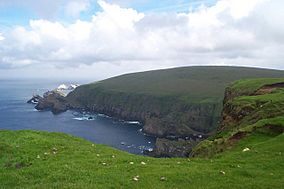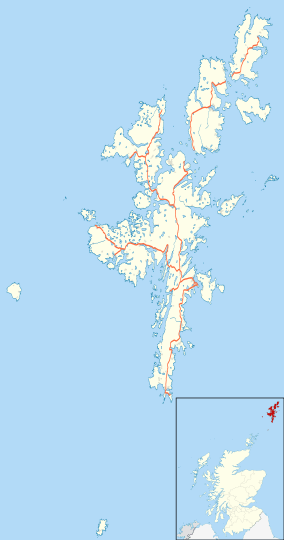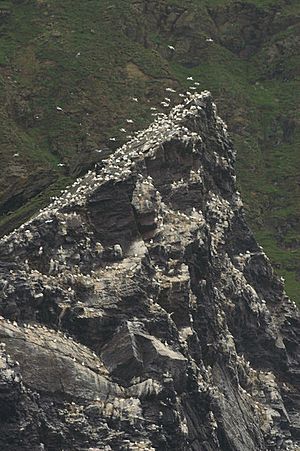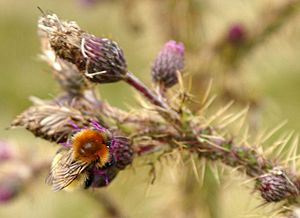Hermaness facts for kids
Quick facts for kids Hermaness National Nature Reserve |
|
|---|---|
|
IUCN Category IV (Habitat/Species Management Area)
|
|

View north from Toolie
|
|
| Location | Shetland, Scotland |
| Area | 964.4 ha (2,383 acres) |
| Designation | NatureScot |
| Established | 1955 |
| Hermaness National Nature Reserve | |
Hermaness is a famous headland in Shetland, Scotland. It's the most northern point of Unst island. This amazing place has huge sea cliffs and wide-open moorland. These features make it a perfect home for many different birds.
Hermaness became a special protected area called a national nature reserve (NNR) in 1955. The reserve covers a large area of 965 hectares (about 2,385 acres). This includes the whole Hermaness peninsula and two small islands nearby, Muckle Flugga and Out Stack. You can explore the reserve using a path and boardwalk that goes across the moorland. NatureScot manages the reserve, but most of the land is still privately owned.
Hermaness is super important for its seabird colonies. It has one of the world's biggest groups of great skuas. You can also see fulmars, gannets, shags, puffins, and guillemots here. The wet, boggy areas further inland are also great for breeding birds like golden plovers, dunlins, and snipes.
There's an old story about Hermaness. People say a giant named Herman once lived here. He fought another giant, Saxa, over a mermaid. The legend says they threw rocks at each other, creating the big rocks and stacks you see around the headland today!
Contents
Amazing Birdlife at Hermaness
More than 100,000 pairs of birds from 15 different types come to Hermaness to breed. It's especially important for great skuas, gannets, and puffins.
Seabirds on the Cliffs
Gannets build their nests on narrow ledges on the cliffs and rock stacks. In 2018, there were about 26,000 pairs nesting here each summer. This means Hermaness is the sixth largest gannet colony in Britain!
Guillemots and kittiwakes also nest on the cliffs. In 2015, about 3,700 pairs of guillemots and 416 pairs of kittiwakes were counted. Shags nest on the rocky beaches. NatureScot estimated around 150 pairs in 2002.
The fulmar population is also very important. In 2011, there were almost 7,000 pairs. Puffins are tricky to count because they nest in burrows underground. However, experts think there are between 20,000 and 30,000 pairs at Hermaness. This is about 6% of all puffins in Britain! You can also find small numbers of herring gulls, razorbills, and black guillemots nesting in hidden spots.
Birds of the Moorland
Away from the coast, almost 1,000 great skuas, also called "bonxies" by locals, nest at Hermaness. They have their territories on the huge moorland in the middle of the peninsula. Hermaness has about 4.5% of the world's great skua population. It's the third largest colony in Europe!
Until the 1960s, many Arctic skuas also bred here. But as bonxie numbers grew, Arctic skuas moved to other parts of Unst. A small number of red-throated divers (usually 3-9 pairs) also nest on the moors. The moorland is also home to many other ground-nesting birds like skylarks, twites, and curlews.
There are also many waders, including lots of dunlins and snipes, and fewer golden plovers. In recent years, greylag geese have also started nesting at Hermaness.
Albert the Albatross
Hermaness was once home to a very rare bird called a black-browed albatross. This bird, nicknamed 'Albert', visited every summer from 1972 to 1995. It was a huge attraction for birdwatchers!
Other Cool Animals
You might sometimes spot an otter at Hermaness. The Shetland field mouse also lives here. Not many other land mammals live on the peninsula.
Marine Life
The seas around Hermaness are full of marine mammals. You can see seals, dolphins, whales, and porpoises. Both grey and common seals visit the beaches often. Seeing whales and dolphins has become more common recently. Harbour porpoises, minke whales, killer whales, white-sided dolphins, white-beaked dolphins, and Risso’s dolphins are all known to visit.
Insects and Bugs
Moths found at Hermaness include the northern rustic and the autumnal rustic. Many of these moths are special types found only in Shetland. They are often darker than those on the Scottish mainland. Other cool bugs include 53 types of beetles, 46 types of spiders, and the unique, orange-colored Shetland bumblebee.
Protecting Hermaness Nature
Efforts to protect Hermaness started way back in 1831. The landowner, Dr. Lawrence Edmondston, began protecting bonxie nesting sites from people who collected eggs. At that time, there were only 3 pairs left! The bonxie population started to grow, but egg collecting was still a problem.
In 1891, the Edmondston family hired a warden to protect the area. After this, bonxie numbers grew a lot. In 1906, the Royal Society for the Protection of Birds (RSPB) took over watching the bonxies. They also started monitoring other seabirds.
In 1955, part of Hermaness became a national nature reserve. It was made even bigger in 1958. Then, the Nature Conservancy Council (now NatureScot) took over watching the birds. Since the 1980s, they have counted seabirds regularly. They do a full count of the main bird types every 6 years.
Hermaness is not just an NNR. It has many other special protections because of its amazing wildlife, habitats, and geology. It's also a Site of Special Scientific Interest (SSSI). It's part of the Hermaness, Saxa Vord and Valla Field Special Protection Area (SPA) and the Shetland national scenic area. Hermaness NNR is known as a Category IV protected area by the International Union for Conservation of Nature.
The Watchers Hut and Memorial
In 1906, when the Royal Society for the Protection of Birds started protecting the Bonxies, they built a hut. It was on the southern slopes of Hermaness Hill, looking over the nesting areas. This hut was for their "Watchers." The first hut burned down, so a slightly bigger one was built. It was made of corrugated iron with a wooden frame and windows facing south.
For many years, Watchers lived in the hut during the breeding season. They stayed until the bonxie population had recovered. After they were no longer needed, the hut was kept as a safe place in bad weather. Researchers and people staying overnight also used it. It also held a visitor's book.
On New Year's Eve 1991, a storm hit Hermaness. It was one of the strongest storms ever recorded in the British Isles. The hut was completely destroyed by the hurricane-force winds. Today, the spot where the hut stood is marked by a cross made of large stones on the ground. It is a memorial for two people who lost their lives during that storm.
Getting to this spot is a bit tricky now. The direct path to the top of Hermaness Hill, which passed the cross, closed in 2017. This was because too many visitors were causing damage to the fragile bog. However, there are plans to reopen this route in the future with new boardwalks. The current path takes a different route to the west.




